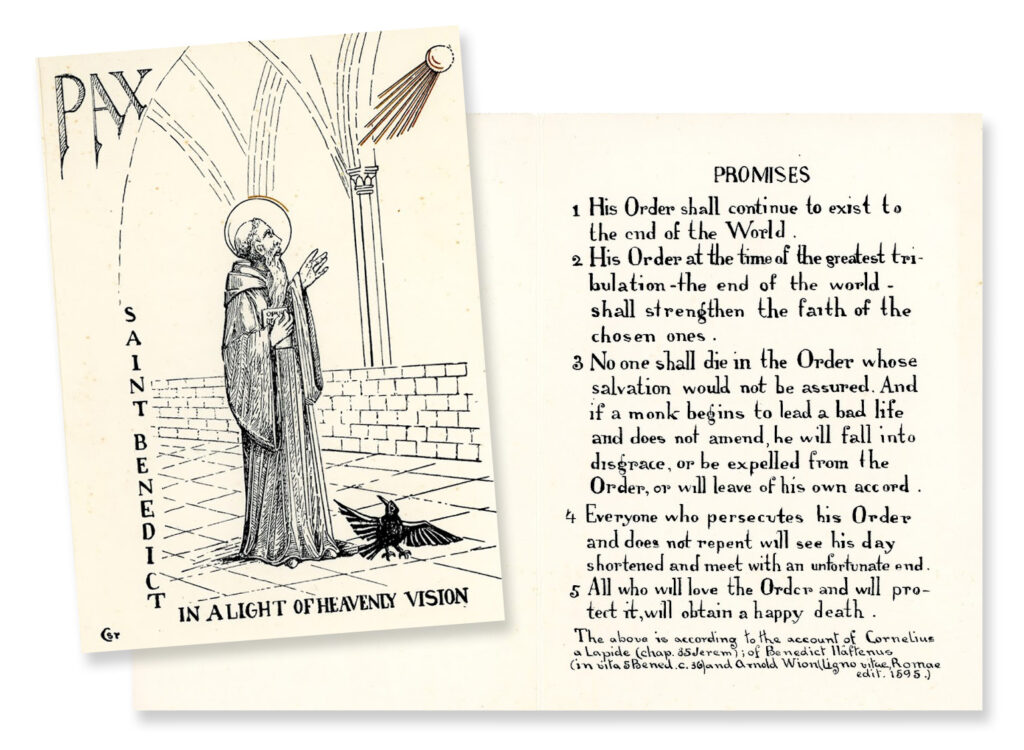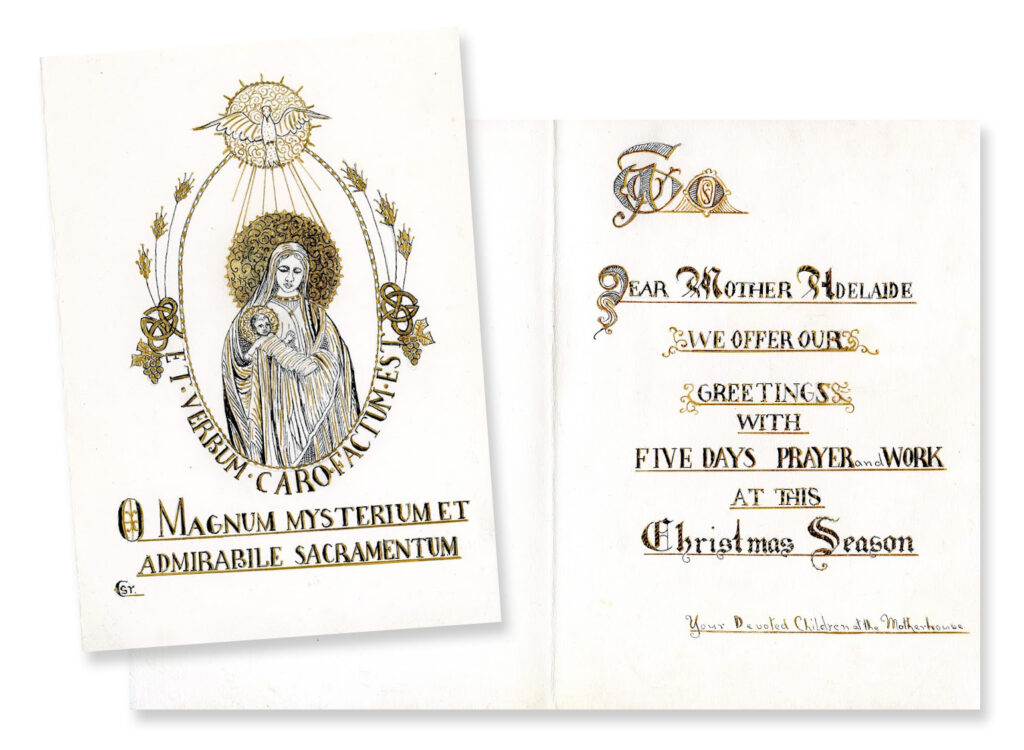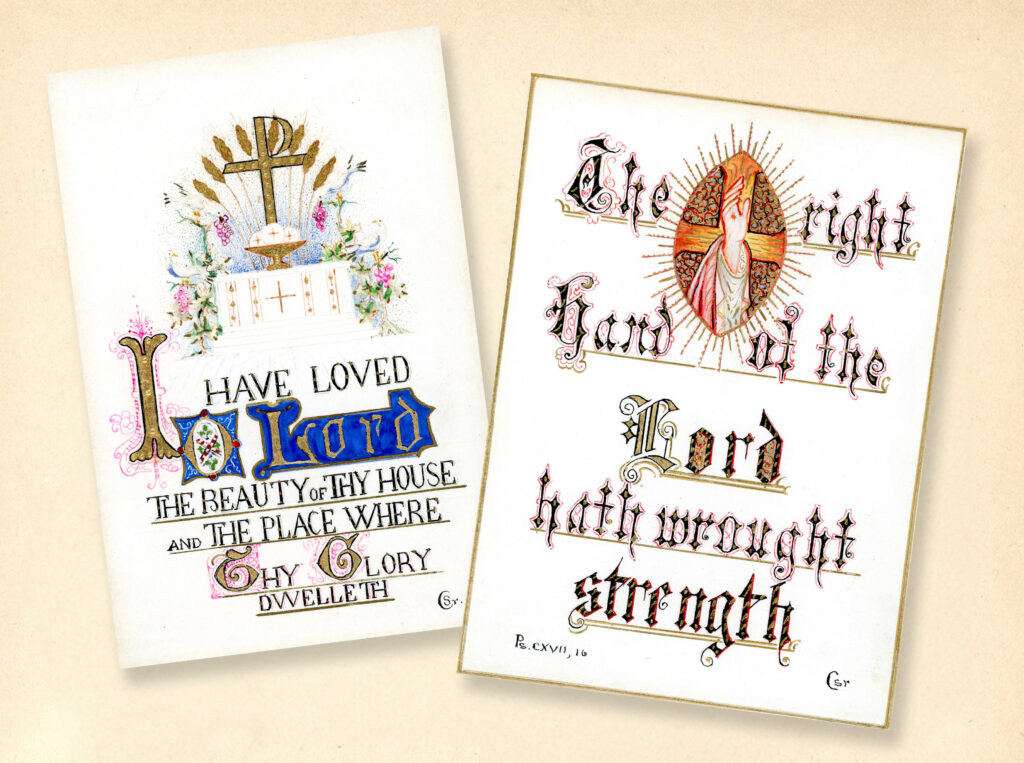Found in the Archives:
Sister Celestine’s Illuminated Manuscripts
Benedictines of Chicago
Sister Virginia Jung, OSB, Community Archivist
Illuminated manuscripts, meticulously handwritten liturgical texts embellished with drawings and calligraphy, are often associated with European monks of the late Middle Ages. However, women religious also created these beautiful artworks. The twelfth-century Carmelite nun Guda is thought to be the first European woman to create a signed self-portrait in her manuscript, now held at the University of Frankfurt. Gisela of Kerzenbroeck created the “Gradual of Gisela,” a thirteenth-century hymnal that likely assisted her during her other monasterial duty as choirmistress. Illuminated manuscripts were prolifically created by the Poor Clares of Cologne, whose existing folio pages depict author-Sisters Isabella of Guelders and Loppa vom Spiegel among others. These fourteenth-century texts characteristically feature depictions of nuns kneeling in the margins, inscribed with their names and prayer requests. Modern research techniques employed by scientists from the University of York revealed that a Sister buried at a monastery in Dalheim, Germany had collected flecks of a blue pigment on her teeth. The particles were identified as lapis lazuli, a pigment so rare it was reserved specifically for the creation of only the most valuable religious texts. They probably accumulated in her mouth as she licked the end of her paintbrush.
While Sister Celestine Fischer, OSB may not have been aware of these women specifically, she would certainly have known of the centuries-long tradition of women monastics creating illuminated manuscripts. Her upbringing in Germany put her in close proximity to a geographic cradle of female illuminators. The founding Sisters of her Chicago monastery originated at St. Walburg Monastery in Eichstätt, Bavaria. These women brought with them the tradition of calligraphy and illumination, practiced since medieval times.
Born in Grosswinternheim, Rhein, Hessen in 1872, Sister Celestine began her artistic studies as a child in Germany. Following the death of her father from tuberculosis, Sister Celestine immigrated to the United States in 1883 with her mother and five siblings. The family settled in Chicago, where she attended St. Joseph School and Saints Benedict and Scholastica Academy, conducted by the Benedictine sisters. In addition to other subjects, the Sisters included instruction in calligraphy and drawing for their high school students. (Evidence of this dates to the Columbian Exhibition of 1893, where students’ Examination Books were on display as part of the Catholic Schools Exhibit.) After entering the monastery, Sister Celestine continued her studies at the Art Institute of Chicago and the University of Notre Dame. She became a United States citizen in 1921. Throughout her lengthy career, Sister Celestine served as an art teacher, novice mistress, principal, chapel designer, and monastery artisan.
During her lifetime, Sister Celestine developed her own distinct style of illumination. In the 1940s, at the age of 70, she was commissioned to create a 14-page manuscript for the 1450th anniversary of the death of St. Benedict of Norcia. It represents the eight canonical hours that Benedictines traditionally pray and the liturgical texts for the mass of the death of St. Benedict. Her pieces were reproduced by her Benedictine community as greeting cards and prayer cards, and often appear amongst the papers of other Sisters who received them as mementos on significant occasions, such as the profession of vows or jubilees.


Sister Celestine’s works demonstrate her commitment to furthering traditions of beauty, her reverence for monastic practices, and advances the contribution of female artists in this important historical practice. Blending traditional European artforms within her modern monastic context, her artwork exemplifies the vital role immigrants can play in shaping America’s cultural and spiritual identity.
___________________________________________
Photos courtesy of:
Benedictine Sisters of Chicago
To learn more and view more photos:
Sr. Celestine: https://sites.google.com/view/lis759jung/home?authuser=0
Sr. Guda: https://sammlungen.ub.uni-frankfurt.de/msma/content/pageview/3644769
Sr. Gisela: https://www.medievalists.net/2020/06/medieval-manuscripts-gradual-of-gisela-von-kerssenbrock/
Sr. Isabella: https://blogs.bl.uk/digitisedmanuscripts/decoration/


